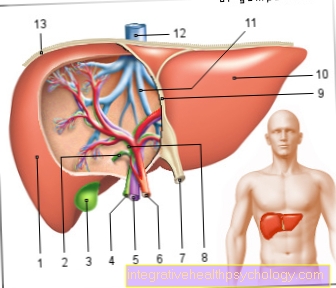Cause of blood in the urine
Synonyms
Hematuria, erythruria, erythrocyturia
English: hematuria
introduction
Blood in the urine, also as Hematuria is a relatively common symptom that can represent a variety of diseases.
Most of the time, these diseases mainly affect the Kidneys, the urinary tract, or the prostate, by the man.
Common and harmless causes are for example Menstrual blood in women, the consumption of beetroot, which can also stain the urine red, or slight bleeding after an operation on the pelvic floor or the urinary tract.
However, blood in the urine also indicate serious illnesses and must therefore be clarified. If it is accompanied by colicky pain and fever, are Kidney stones or one Inflammation of the prostate probably. Painless blood in the urine may indicate a malignant disease such as a urinary tract tumor (Urothelial carcinoma), and must be examined by a doctor.
In the case of hematuria, a basic distinction is made between microhematuria, which means that there are tiny amounts of red blood cells in the urine that can only be seen under a microscope, and macrohematuria, where the urine is visibly bloody.

Classification
The symptom of blood in the urine is divided into two forms in terms of the amount of blood:
- Microhematuria
- Macrohematuria
Microhematuria denotes that for the human eye invisible appearance of blood in the urine, the urine does not show any red color and the blood can only be detected microscopically. During the microscopic examination, the visible area is divided into so-called visual fields; up to four red blood cells per visual field are normal. In contrast, with one
Macrohematuria the urine can be seen with the naked eye (macroscopic) a reddish or brownish color due to the admixture of blood. A visible color arises from an amount of about 1 ml blood per liter urine.
The causes of blood in the urine are numerous. Possible sources of bleeding can be:
- Kidney disease:
- Diseases of the bladder, of Ureter (Ureter) and the urethra (urethra):
- Diseases of the prostate: Inflammation, tumor
- Physical exertion: March hematuria
- Bleeding disorders
- Menstruation
Classification by gender
Causes in men

The most common causes of blood in the urine in men are Kidney disease, such as Urinary tract diseases and the prostate.
A very common disease that can cause blood in the urine and severe, colicky pain is kidney disease. Ureteral stones. Kidney stones occur mostly in men, between the ages of 30 and 60. Year of life.
Risk factors are strong among other things Obesity, gout, as well as a high protein diet.
Therapeutically, ureter stones less than 5 millimeters can be waited for spontaneous discharge, with the administration of painkillers and antispasmodics (e.g. Buscopan®).
Larger stones, over 5 millimeters, can be sent by Shock wave lithotripsy (ESWL) or removed under a ureter mirror. As a preventive measure, we recommend sufficient exercise, plenty of drinking (up to 2.5l per day) and a reduced consumption of animal fats.
Also one Prostate inflammation can with strong Painful urination, fever, and Blood in the urine accompanied. Risk factors for prostate inflammation are urination disorders and manipulation of the genitourinary tract (like inserting a urinary catheter). Therapeutically, antibiotics are prescribed for four weeks. Rarely in men, but possible, especially in older men in need of care with urinary catheters, are urinary tract infections or a Cystitiswhich can also be accompanied by painful urination, frequent urination and occasionally blood in the urine.
Risk factors are urinary catheters in place and diabetes mellitus. Antibiotics are administered therapeutically. If the urinary catheter is the source of infection, it should be withdrawn immediately.
Another possible cause of blood in the urine is Tumors.
The most common tumor in men that can also be accompanied by blood in the urine is Prostate cancer. The main risk factors are age and a family predisposition. Prostate cancer can spread Blood in the urine, Urinary retention, Incontinence, impotence, such as Pain in the bones express.
However, since these symptoms appear very late, it is important that men over the age of 45 regularly go to preventive care where prostate cancer can be detected early. The gold standard in prostate cancer therapy is radical removal of the tumor. In the case of slowly growing tumors or older patients, however, a conservative approach with antihormonal therapy can also be considered.
Another tumor that has blood in the urine is this Urothelial carcinoma, a malignant disease that originates from the lower urinary tract and mainly affects men over the age of 65.
It can remain asymptomatic for a long time and only falls through painless macrohematuria (visible blood in the urine). The most important risk factor for developing urothelial cancer is smoking. If the cancer is discovered early, a minimally invasive operation can be performed therapeutically. If the tumor is discovered late or if it has already grown into the surrounding tissue, radical surgery is necessary Removal of the urinary bladder with artificial urinary diversion.
In terms of prognosis, many patients develop relapses.
Another malignant tumor that has blood in the urine is renal cell carcinoma, the most common Kidney tumorwhich occurs mainly in men. Risk factors are again Smoke, Obesity, high blood pressure and chronic kidney failure. Renal cell carcinoma is usually asymptomatic, but can be associated with flank pain and macrohematuria. Therapeutically, the tumor must always be surgically removed, either as Partial kidney resection or as radical kidney removal.
Overall, renal cell carcinoma has a very good prognosis, as it can now be detected early.
Other causes of blood in the urine in men can include bleeding during surgery or procedures in the genitourinary tract, or accidents with injuries to the genitourinary tract. Chronic kidney damage, for example due to poorly controlled diabetes mellitus or poorly controlled blood pressure, can lead to microhematuria (only microscopically visible blood in the urine) to lead. If microhematuria is present, the blood sugar or blood pressure should be adjusted more optimally in order to avoid further kidney damage.
Ultimately, bleeding disorders or the use of certain medications can lead to blood in the urine or to a red coloration of the urine.
Causes in women
The most common and harmless cause of blood in the urine in women is Menstrual blood.
If bleeding occurs outside of the regular period, a gynecological evaluation should be carried out so that pathological processes such as Cysts, Polyps (benign growths of the uterine lining), or tumors can be excluded.
Another very common cause of blood in the urine in women is Cystitis. Bladder infections and urinary tract infections are very common in women because the anatomically very short urethra means that bacteria can rise much faster and lead to inflammation.
Signs of a cystitis are especially common and painful urination, Blood in the urine, as well Abdominal pain. If flank pain, fatigue and fever are added, this can be a problem Pelvic inflammation Clues.
A bladder infection and an inflammation of the kidneys should be examined by a doctor and treated with antibiotics.
Other causes of blood in the urine in women can include kidney and kidney disease Ureteral stones be. Risk factors for this are above all very overweight, gout, one small amount of drink, as well as one strong protein-heavy diet. But also rheumatic diseases, such as the systemic Lupus erythematosus (SLE), can lead to bloody urine if the kidneys are involved.
Rarely, and more common in men, kidney tumors or tumors of the lower urinary tract can also cause blood in the urine. The most common risk factor for these tumors to develop is that Smoke and older age. But also injuries, operations or manipulation of the genitourinary tract (for example inserting a urinary catheter), Bleeding disorders or the use of certain medications can lead to blood in the urine.
Causes in the child / toddler
Blood in the urine in children should always be checked by a doctor. It can be triggered by inflammation of the kidneys and the lower urinary tract, as well Cystic kidneys be. Cyst kidneys are mostly congenital diseases that are genetically inherited. Some forms become symptomatic after birth, others only in childhood or young adulthood. Common to all forms, however, is the formation of cysts (Formation of fluid-filled cavities) which left untreated to a Kidney failure leads. Symptoms include blood in the urine, flank pain and a Proteinuria (Excretion of proteins in the urine). Therapeutic is the early detection of the disease and the prevention of a Renal failure in the foreground. For this purpose kidney-damaging substances (for example pain relievers such as aspirin, ibuprofen or diclofenac) must be avoided at all costs and the blood pressure set optimally.
However, blood in the urine in young children can also affect one Wilms tumor Clues. This is the most common malignant kidney tumor in children, especially between the 2nd-4th age occurs.
The causes are still largely unexplained, but a genetic predisposition is suspected. Wilms' tumors are often asymptomatic at first, or go with them Exhaustion, Loss of appetite and a bulging, "thick“Belly along.
Blood in the urine and pain are rare. Since Wilms tumors often metastasize early on, the treatment of choice is radical, surgical removal of the kidney followed by chemotherapy, possibly with additional radiation.
Overall, however, the Wilms tumor has a very good prognosis; around 85% of patients can be cured.
Another cause of a painless Macrohematuria (visible blood in the urine) is the IgA nephropathy. It occurs mainly in children and young adults and causes inflammation of the kidney cells (Glomeruli). The cause is still largely unknown, but it is assumed that after minor respiratory infections, defective antigen-antibody complex formation occurs, which are deposited in the kidneys and damage the kidneys.
IgA nephropathy is shown by frequent, painless blood in the urine. The disease is self-limiting and usually no treatment is necessary. Nevertheless, a doctor should be consulted for clarification and regular control.
Causes of blood in the urine during pregnancy
A common cause of blood in the urine during pregnancy is one Cystitiswhich is usually associated with painful and frequent urination and can be treated well with an antibiotic.
If a bladder infection has been ruled out, the bleeding may also be from the uterus. Often this is due to hormonal disorders or burst small veins in the cervix that is well supplied with blood.
It helps to take it easy in the first few months of pregnancy and to refrain from sport and sexual intercourse. Magnesium intake can also help.
However, if there is very heavy bleeding that is accompanied by back or abdominal pain, it could also be a miscarriage. Pregnant patients with blood in their urine should definitely see their gynecologist.
Kidney diseases as the cause
Kidney disorders associated with blood in the urine include inflammation (Glomerulonephritis, pyelonephritis), Kidney stones (Nephrolithiasis), Kidney cancer (for example renal cell carcinoma and renal pelvic carcinoma), cystic kidney changes or diseases of the blood vessels (embolism, thrombosis). Also kidney damage in the presence of Diabetes mellitus (diabetic nephropathy) may be accompanied by blood in the urine.
In terms of bladder, ureter and urethra Urinary tract infections, other inflammations, injuries, strictures, stones and tumors (Bladder carcinoma, urethral carcinoma, ureter carcinomaResult in blood in the urine. Endometriosis, a disease in which the lining of the uterus is dispersed into the urinary tract is another cause of blood in the urine, as this mucous membrane is also subject to the female menstrual cycle.
Blood clotting disorders such as a lack of blood platelets (thrombopenia), hemophilia (hemophilia) or drug-induced decrease in blood clotting (Marcumar, Heparin) may cause blood in the urine.
Depending on the disease, one speaks of glomerular or postglomerular hematuria.
In the first form, there is damage to the structural units of the kidneys (Glomerulum = Kidney corpuscles), in the second case these structures are intact and the cause of the bleeding is to be found in changes in the structures downstream of the kidney corpuscles. These two forms of hematuria can be distinguished from one another based on the appearance of the red blood cells in the urine, since in glomerular hematuria these change their shape (morphology).
The urine may also be red in color even though it does not contain blood. Causes for this are, for example, the consumption of certain foods (beetroot), myoglobinuria (Myoglobin = Oxygen carrier of Musculature) after muscle breakdown or the drug rifampicin (antibiotic).


























.jpg)


